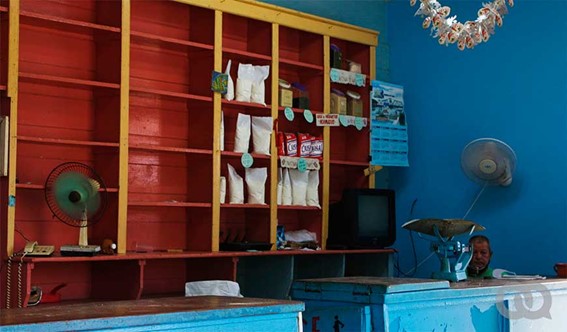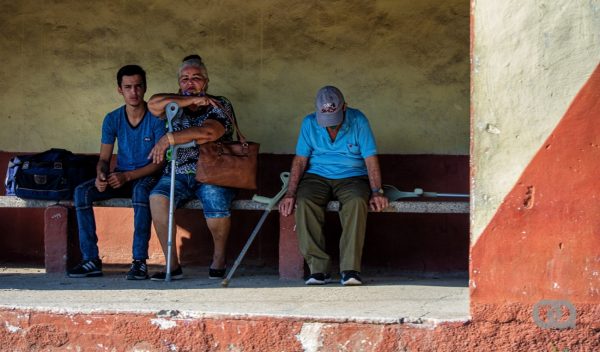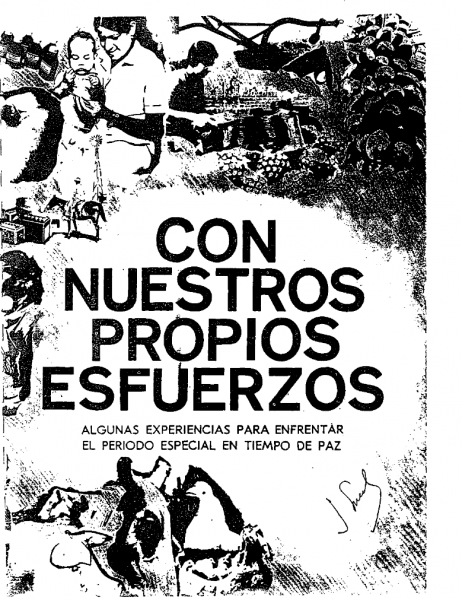Cuba’s Special Period Book: Memories Best Forgotten
By Glenda Boza Ibarra (El Toque)

HAVANA TIMES – Pizza with condoms instead of cheese, minced banana skin, cat fricassee and mop steak. Those were some of the recipes and scams that emerged during the Special Period crisis of the ‘90s. While some of these were fictional and only became famous as popular jokes, many of these outlandish dishes did in fact exist and are documented.
Wefound the book compiling some of the ‘solutions’ that enabled Cubans to get through this period of extreme crisis. Looking at these recipes today, some of these dishes are so ‘pleasant’ that they remind us of that Tony Avila song with the chorus that goes: “Not even the Japanese can invent what the Cubans did in the ‘90s, not even in haste.” However, it also reveals the Cuban people’s desperation when pretty much everything was in shortage. Moreover, a trauma exceedingly difficult to overcome for those of us who lived it.
The Special Period Book
Con nuestros propios esfuerzos (With our own effort) – was put out by Verde Olivo Publishers, 1992. It is a compilation of Cuban inventions during the crisis that ensued after the USSR collapsed.
Divided up into different chapters and with almost 300 pages, it collects over 1000 experiences that were used in agriculture, animal rearing, public services, the energy sector, housing, building materials, crafts and games, education, culture, sport and military defense.
The book’s foreword explains: “Unfortunately, not every municipality sent in their experiences. Likewise, not everything the Publishing House received described the experience properly. Other times, they only talked about how important these inventions are, without offering the necessary details for them to be featured.”
According to the explanation at the beginning, the collection didn’t expand on the science behind these inventions. Instead, it focused on their value on their use in practice. The book was edited in haste so that these alternatives could extend to every province in the country. However, it isn’t a compilation of magical solutions.
Living it isn’t the same as telling the story
According to the ‘inventions’ selected in this book to tackle the crisis during that period, 1992 is very similar to 2020. Recipes for shampoo, hair conditioners, hair bleach, soap, etc., are being rescued by those most affected by the shortages of personal hygiene items, today.
One of the most remarkable products is talcum powder made out of eggshells. As well as the use of agave stalks for soap, detergent and scourers. Nail varnish remover is also being made with alcohol and nail polish, and anti-dandruff lotion is being made out of cow bile.
Alternatives are also appearing in the face of shortages of medicine and medical supplies. These range from agave fibers being used for surgical sutures to using aloe vera gel for ultrasounds. Even though it might seem hard to believe, these solutions did exist and are published.
What the financial crunch meant
A figure that reveals the profound crisis during those years which was reflected in Cuba’s ability to import. Imports fell from some 8.2 billion pesos (in theory = USD) in 1989 to 2.7 in 1992. That was the first tough year during the special period, although worse was yet to come.
Maybe this was why other ‘innovations’ such as furniture made from old thrown-out TV boxes, ovens made out of scrap metal and money-saving charcoal ovens, proved the Cuban people’s creativity… and also their desperation. However, these initiatives are more quick-fixes than solutions, in most cases.
Even though 28 years have passed since these ideas first came along, many have developed over time. In the face of shortages, some have been forgotten and others are still being used today. Products featured in the book – skimmers, devices to make fried plantain slices, sealing rings for pressure cookers with a piece of thin plastic jump rope, mortar or wire hangers – can still be found today in many Cuban kitchens, especially in the homes of people with low incomes, and as something self-employed workers sell.
It’s striking that in Con nuestros propios esfuerzos, many of these inventions come from rural areas in the central-eastern part of Cuba.
Maybe this is why you can find instructions on how to build rustic houses out of boards, bamboo, mud and wood or blocks made out of rice husk. None of these houses would survive a hurricane, of course. However, they continue being the homes of many poor people, especially those living in illegal neighborhoods or fringe settlements.
Deja Vu Cuban Kitchens
Up until recently, statements made by the minister of Agriculture about using chitterlings in our diets, or rearing “decrepit chickens’ were the subject of outrage and jokes on social media. An invitation from Tribuna newspaper to “appreciate” the nutritional value of banana skins was also rejected in the same way.
There are other jokes too, such as eating moringa or rearing ostriches, crocodiles and hutias to make tasty dishes. While none of these suggestions are completely absurd, they do border on insensitivity. Especially when people have been navigating long lines and high food prices for over a year now. The same country where food is a matter of National Security.
The food crisis during the Special Period had some impact in the rising rate of malnutrition. Likewise, an epidemic of optic and peripheral neuropathy in Cuba, a condition linked to nutritional disorders.
When there is no choice
Cubans had to eat whatever there was. In the book published by Verde Olivo, some experiences tell us how meat by-products could be taken advantage of. Ears, trachea, oesophagus, intestines, lips (yes, lips!), tendons and other bits that used to be thrown away. In addition, how these are used to make croquettes, homemade blood sausages and a type of hamburgers.
The use of chitterlings continues to be an issue which – in spite of memes online – isn’t funny. However, recent experiences posted by mothers and groups on social media tell us that there are lots of people ‘sticking their hands’ into anything they can find and picking up some of these ‘ready-made’ products to feed their family.
However, neither using “meat waste” or edible plants in our diets are a magical solution to deal with the complex landscape of recent years.
Improvements in Cuban diets will only come once farm and industrial production increase. Moreover, once the economy becomes more diverse and imports are reduced. Giving producers freedom and getting rid of hurdles and bureaucratic redtape for those who want to produce, is also inevitable.

A period nobody wants to repeat
A viral meme on social media has the phrase: “We want young people who didn’t live during the Special Period, to have their own Special Period.” The meme is a year old now. It was first posted when the temporary situation of fuel shortages began.
At that time, Cuban president Miguel Diaz-Canel said that Cuba wasn’t experiencing a new Special Period. Nevertheless, in a TV appearance in September 2019, he told Cubans to “dust off” measures applied in the early 1990s. He noted, “they were useful back then, and can be again now.”
A year after these statements from the Cuban leader, the situation in Cuba is a lot worse now. The main reason has been the COVID-19 pandemic. Also, tighter US sanctions; the drop in tourism, exports, imports, and the inefficient management of much of the national economy.
Differences and similarities
While the brutal memory of the Special Period continues to haunt the island, the absence of long blackouts and other more difficult conditions in those years still don’t classify today’s crisis with the ‘90s euphemism.
However, chronic shortages often bring back memories of those years. Con nuestros propios esfuerzos, rather than a self-help book, is a testimony. It describes what the Cuban people had to do to survive. It’s a book that is an interesting read… and also sad.
The Cuban solution to avoid going back to the Special Period, is to not accept shortages as a life philosophy. Neither is picking up on alternatives to alleviate the crisis, that comes in cycles for us, a solution. The country needs transformations that really advocate for the sovereignty they speak so much of in speeches and pep talks.
A lot more must be done, and lot less said, so changes don’t happen at a snail’s pace. The minister of Economy, Alejandro Gil, recognized this when talking about making exports and imports more flexible.
Many younger readers might find many of the experiences in Con nuestros propios esfuerzos funny and even reason to mock. However, they are the reflection of the desperate situation that we lived in the 1990s, and the Cuban people’s resilience. Cubans who didn’t have any choice but to invent in order to survive… and today we continue inventing to survive.






